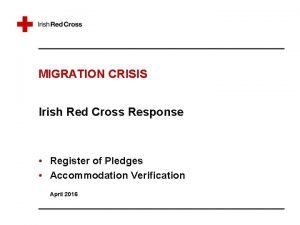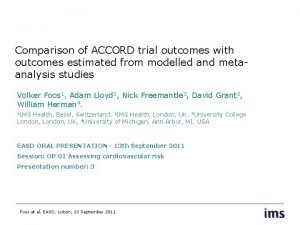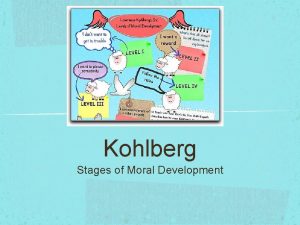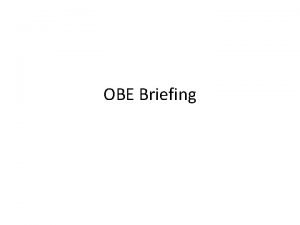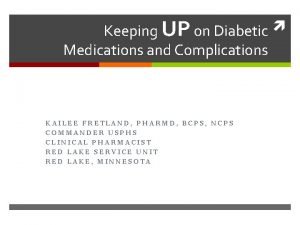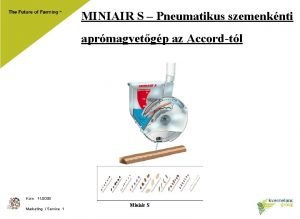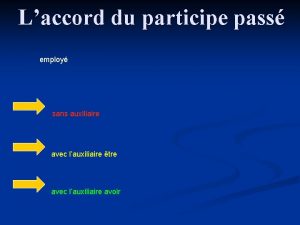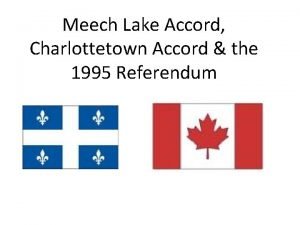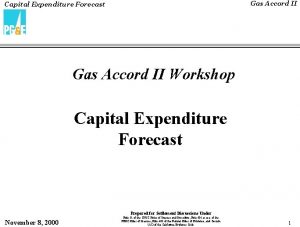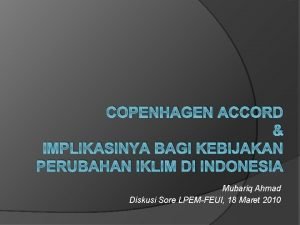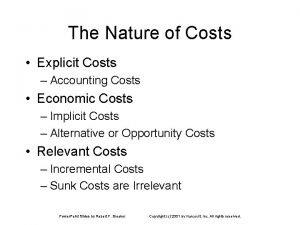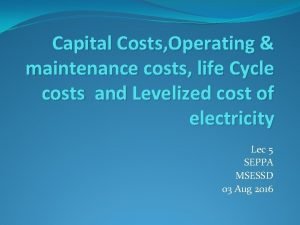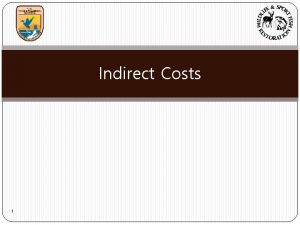Copenhagen Accord Pledges imply higher costs for staying















- Slides: 15

Copenhagen Accord Pledges imply higher costs for staying below 2°C warming Michel den Elzen Jasper van Vliet Mark Roelfsema Andries Hof

Conclusions (1) § If all countries implement their unconditional pledges, achieving the 2°C goal with medium likelihood becomes difficult § If all countries implement their ambitious, conditional pledges the 2°C goal can still be met with a likely chance, but: – with higher mitigation costs after 2020 – long-term dependence on rapid reductions through all mitigation technologies (including BECCS) – reduced long-term flexibility Source: Van Vliet et al. (2012). ‘Achieving a 2 °C target from Copenhagen Accord pledges comes at a cost’, Climatic Change, DOI 10. 1007/s 10584 -012 -0458 -9 2 18 May 2012 Michel den Elzen| Copenhagen Accord Pledges imply higher costs for staying below 2°C warming

Non-cost effective pathways may also achieve 2°C: starting at higher 2020 emissions (450 ppm CO 2 eq) Source: Van Vliet et al. (2012). ‘Achieving a 2 °C target 3 from Copenhagen Accord pledges comes at a cost’, Climatic Change, DOI 10. 1007/s 10584 -012 -0458 -9 18 May 2012 Michel den Elzen| Copenhagen Accord Pledges imply higher costs for staying below 2°C warming

For higher 2020 emissions same concentration targets can not achieved, therefore higher targets assumed Source: Van Vliet et al. (2012). ‘Achieving a 2 °C target 4 from Copenhagen Accord pledges comes at a cost’, Climatic Change, DOI 10. 1007/s 10584 -012 -0458 -9 18 May 2012 Michel den Elzen| Copenhagen Accord Pledges imply higher costs for staying below 2°C warming

With BECCS faster, deeper reductions towards concentration target of 400 ppm CO 2 eq (2. 6 W/m 2) Source: Van Vliet et al. (2012). ‘Achieving a 2 °C target 5 from Copenhagen Accord pledges comes at a cost’, Climatic Change, DOI 10. 1007/s 10584 -012 -0458 -9 18 May 2012 Michel den Elzen| Copenhagen Accord Pledges imply higher costs for staying below 2°C warming

Higher long-term mitigation costs after 2020 Source: Van Vliet et al. (2012). ‘Achieving a 2 °C target 6 from Copenhagen Accord pledges comes at a cost’, Climatic Change, DOI 10. 1007/s 10584 -012 -0458 -9 18 May 2012 Michel den Elzen| Copenhagen Accord Pledges imply higher costs for staying below 2°C warming

Cost-effective emission pathways Scenario name 2020 2050 Date of emissions peaking emissions Optimal 2. 9 W/m 2 Gt. CO 2 eq 44. 3 Gt. CO 2 eq 26. 6 Year 2016 44. 6 24. 1 2016 Optimal BECCS 2. 6 W/m 2 Source: Van Vliet et al. (2012). ‘Achieving a 2 °C 7 target from Copenhagen Accord pledges comes at a cost’, Climatic Change, DOI 10. 1007/s 10584 -012 -0458 -9 Cumulative Probability discounted not to mitigation costs exceed 2°C by 2100 Trillion US$ % 10. 6 59 11. 5 73 18 May 2012 Michel den Elzen| Copenhagen Accord Pledges imply higher costs for staying below 2°C warming

Conditional pledges: same chance 2 o. C, but higher costs, all options needed (BECCS) & reduced flexibility Scenario name Optimal 2. 9 W/m 2 Optimal BECCS 2. 6 W/m 2 Copenhagen Potential 2. 9 W/m 2 Copenhagen Potential BECCS 2. 6 W/m 2 2020 2050 Date of emissions peaking emissions Cumulative Probability discounted not to mitigation costs exceed 2°C by 2100 Trillion US$ % 10. 6 59 Gt. CO 2 eq 44. 3 Gt. CO 2 eq 26. 6 Year 2016 44. 6 24. 1 2016 11. 5 73 47. 1 25. 7 2024 12. 1 58 47. 1 21. 8 2022 12. 9 73 Source: Van Vliet et al. (2012). ‘Achieving a 2 °C 8 target from Copenhagen Accord pledges comes at a cost’, Climatic Change, DOI 10. 1007/s 10584 -012 -0458 -9 18 May 2012 Michel den Elzen| Copenhagen Accord Pledges imply higher costs for staying below 2°C warming

Unconditional pledges: lower chance of achieving 2 o. C Scenario name 2020 2050 Date of emissions peaking emissions Optimal 2. 9 W/m 2 Gt. CO 2 eq 44. 3 Gt. CO 2 eq 26. 6 Year 2016 Optimal BECCS 2. 6 W/m 2 Copenhagen Potential 2. 9 W/m 2 Copenhagen Potential BECCS 2. 6 W/m 2 Current Copenhagen 3. 2 W/m 2 44. 6 24. 1 2016 11. 5 73 47. 1 25. 7 2024 12. 1 58 47. 1 21. 8 2022 12. 9 73 51. 4 33. 2 2026 9. 2 37 Current Copenhagen BECCS 2. 8 W/m 2 51. 4 26. 7 2024 10. 7 60 9 Cumulative Probability discounted not to mitigation costs exceed 2°C by 2100 Trillion US$ % 10. 6 59 18 May 2012 Michel den Elzen| Copenhagen Accord Pledges imply higher costs for staying below 2°C warming

Only 2. 6 -2. 8 W/m 2 scenarios achieve stabilization or slow decline in warming by 2100. Others show increase Source: Van Vliet et al. (2012). ‘Achieving a 2 °C target from Copenhagen Accord 10 pledges comes at a cost’, Climatic Change, DOI 10. 1007/s 10584 -012 -0458 -9 18 May 2012 Michel den Elzen| Copenhagen Accord Pledges imply higher costs for staying below 2°C warming

Conclusions (2) However, a new PBL study shows (also by UNEP Briding the Gap report): § Since Cancun (2010) there is new information of business-asusual emission projections of mainly developing countries, which have increased emissions expected from pledges to [51– 55 Gt. CO 2 e] in 2020 § Therefore achieving 2°C becomes even more difficult, even under non-cost effective pathways Source: den Elzen, Roelfsema and Hof (2012) ‘Analysing the emission gap between pledged emission reductions under the Cancún Agreements and the 2 °C climate target’, PBL report, www. pbl. nl/en 11 18 May 2012 Michel den Elzen| Copenhagen Accord Pledges imply higher costs for staying below 2°C warming

Higher global emissions expected from pledges between 51 and 55 Gt. CO 2 eq 12 Source: den Elzen, Roelfsema and Hof (2012) ‘Analysing the emission gap between pledged emission reductions under the Cancún Agreements and the 2 °C climate target’, PBL report, www. pbl. nl/en 18 May 2012 Michel den Elzen| Copenhagen Accord Pledges imply higher costs for staying below 2°C warming

Higher global emissions expected from pledges between 51 and 55 Gt. CO 2 eq 13 Source: den Elzen, Roelfsema and Hof (2012) ‘Analysing the emission gap between pledged emission reductions under the Cancún Agreements and the 2 °C climate target’, PBL report, www. pbl. nl/en 18 May 2012 Michel den Elzen| Copenhagen Accord Pledges imply higher costs for staying below 2°C warming

The emission gap towards achieving the 2 °C goal ranges from 7 to 11 Gt. CO 2 eq for a likely chance 14 18 May 2012 Michel den Elzen| Copenhagen Accord Pledges imply higher costs for staying below 2°C warming

The emission gap towards achieving the 2 °C goal is expected even for non cost-effective pathways! 15 18 May 2012 Michel den Elzen| Copenhagen Accord Pledges imply higher costs for staying below 2°C warming
 Qltc pledges
Qltc pledges Irish red cross register of pledges
Irish red cross register of pledges Exchange of pledges between lords and vassals
Exchange of pledges between lords and vassals Accord du verbe avec plusieurs sujets
Accord du verbe avec plusieurs sujets Pilar 1 basel 2
Pilar 1 basel 2 Accord exchange adx 600
Accord exchange adx 600 Accord trial summary
Accord trial summary Veux-tu briser du péché le pouvoir
Veux-tu briser du péché le pouvoir Interpersonal accord and conformity examples
Interpersonal accord and conformity examples Washington accord
Washington accord The seoul accord agreement accredits
The seoul accord agreement accredits Accord trial summary
Accord trial summary Dm accord
Dm accord Accord miniair
Accord miniair Le participe passé employé sans auxiliaire
Le participe passé employé sans auxiliaire Grand corps malade train
Grand corps malade train

